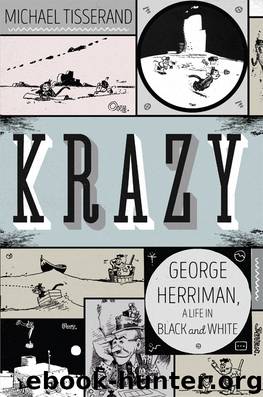Krazy by Michael Tisserand

Author:Michael Tisserand
Language: eng
Format: epub
Publisher: HarperCollins
Published: 2016-11-04T04:00:00+00:00
From Krazy Kat, November 19, 1922
courtesy Heritage Auctions
For Herriman, lantern-lit Kayenta evenings around the Wetherills’ table provided a rare respite from an increasingly busy career. By the start of the twenties, Krazy Kat was both popular and profitable. No Hearst financial records have surfaced to reveal Herriman’s salary during this time, but newspaper columnist O. O. McIntyre reported in 1918 that “comic artists are among the highest paid men in New York,” with few receiving less than $15,000 a year, or nearly a quarter of a million dollars today, adding that Herriman “is said to be one of the highest salaried men in the world of the comic strip.” It is unlikely, however, that Herriman’s salary topped enormously successful artists such as Bud Fisher, whose Mutt and Jeff earned him $200,000 annually, as reported in Editor & Publisher in 1919.
Krazy Kat’s fame increased even more when a new round of films hit the movie screens. In 1920, Bray Studios released ten new cartoons that boasted better production values than the International Film Service series. The Bray films were loosely based on some of Herriman’s comics, with numerous Coconino supporting characters joining in. Herriman-style flourishes abounded in these new cartoons, as in The Great Cheese Robbery, in which a Hearst newspaper comes to life, personifying Ignatz’s troubled conscience.
Toy shelves filled with new creations modeled after Herriman’s characters. The Averill Manufacturing Company had started producing felt Krazy Kat dolls and wholesaling them to retailers for twelve dollars a dozen with the promise: “The Big Skream: Kraziest Kat You ever Looked At.” Stuffed with sawdust, the Averill doll stood about twenty inches tall with a tag nose and pointy ears, a fixed smile, and a white face on a black, purple, or orange body. Other toys included a wood-and-rope Ignatz, produced by the Cameo Doll Company, with the stamped name “Ignatz” on its chest and a small tag on the foot stating “Des. & Copyright by Geo. Herriman.” A special Krazy Kat doll even showed up at a Yale football game, where it was spotted by writer Damon Runyon, who complained, “George Herriman’s ‘Krazy Kat,’ done in Yale blue, was about the only innovation in souvenirs seen in town and they wanted five dollars for that.”
Still, Herriman knew there were risks in building a career solely on talking animals. In 1920 Moses Koenigsberg, president of Hearst’s King Features Syndicate, spelled out his views of what makes a good comic. Newspaper features, he emphasized, are built around human beings. “As an illustration of what I mean, let us analyze ‘Bringing Up Father,’ which is the strongest comic feature in the world today—the ideal ‘funny,’” he wrote. Koenigsberg singled out McManus for keeping his comic “both human and humorous.”
Yet Herriman’s only remaining “human” strip, Baron Bean, had recently concluded its three-year run. As with The Dingbat Family, the end came suddenly. The Baron had been going on far-flung adventures that took him far from his roots in Dickens and Chaplin. Then, in the final Baron
Download
This site does not store any files on its server. We only index and link to content provided by other sites. Please contact the content providers to delete copyright contents if any and email us, we'll remove relevant links or contents immediately.
Cecilia; Or, Memoirs of an Heiress — Volume 2 by Fanny Burney(31871)
Cecilia; Or, Memoirs of an Heiress — Volume 3 by Fanny Burney(31854)
Fanny Burney by Claire Harman(26526)
We're Going to Need More Wine by Gabrielle Union(18967)
Plagued by Fire by Paul Hendrickson(17331)
All the Missing Girls by Megan Miranda(15573)
Cat's cradle by Kurt Vonnegut(15184)
Bombshells: Glamour Girls of a Lifetime by Sullivan Steve(13975)
Leonardo da Vinci by Walter Isaacson(13182)
For the Love of Europe by Rick Steves(13000)
4 3 2 1: A Novel by Paul Auster(12283)
Adultolescence by Gabbie Hanna(8857)
The remains of the day by Kazuo Ishiguro(8822)
Note to Self by Connor Franta(7621)
Diary of a Player by Brad Paisley(7487)
Giovanni's Room by James Baldwin(7192)
What Does This Button Do? by Bruce Dickinson(6134)
Ego Is the Enemy by Ryan Holiday(5294)
Born a Crime by Trevor Noah(5294)
